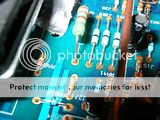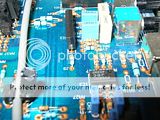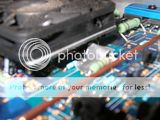Stein
Stein
If anybody happens to be accustomed to single-layer PCBs, let me know.
there's no way I'm getting to the back of this PCB to re-solder that capacitor. All of the important amplifier things (transistors...?) are glued/taped down to the casing with thermal tape.
There are, however, copper rings around all of the holes in the PCB for the component-leads. Do you think that these copper bits are linked to the solder joint on the other side, or just a remnant of cutting the holes?
Here are the rings I'm talking about:

And just in case here's the capacitor that was half detached. I put the broken lead into its hole and taped down the capacitor, but I have no idea if the lead is making contact or if the duct tape is safe.

I'm assuming the duct-tape glue is non-conductive, but you know what they say about assuming...
All help appreciated. I want to get this thing in my car and hooked up already.
there's no way I'm getting to the back of this PCB to re-solder that capacitor. All of the important amplifier things (transistors...?) are glued/taped down to the casing with thermal tape.
There are, however, copper rings around all of the holes in the PCB for the component-leads. Do you think that these copper bits are linked to the solder joint on the other side, or just a remnant of cutting the holes?
Here are the rings I'm talking about:


And just in case here's the capacitor that was half detached. I put the broken lead into its hole and taped down the capacitor, but I have no idea if the lead is making contact or if the duct tape is safe.

I'm assuming the duct-tape glue is non-conductive, but you know what they say about assuming...
All help appreciated. I want to get this thing in my car and hooked up already.
